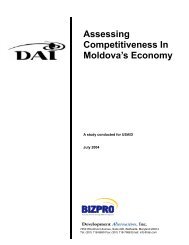Trade and Commercial Law Assessment - Honduras - Economic ...
Trade and Commercial Law Assessment - Honduras - Economic ...
Trade and Commercial Law Assessment - Honduras - Economic ...
You also want an ePaper? Increase the reach of your titles
YUMPU automatically turns print PDFs into web optimized ePapers that Google loves.
TRADE AND COMMERCIAL LAW ASSESSMENT DECEMBER 2004<br />
HONDURAS<br />
a. <strong>Trade</strong> Facilitation<br />
Issues to Address<br />
<strong>Honduras</strong> should make the following improvements to its roadway system:<br />
♦ Exp<strong>and</strong> roadway capacity <strong>and</strong> improve levels of service between Tegucigalpa <strong>and</strong> Puerto<br />
Cortez. This two-lane corridor provides Honduran, El Salvadoran, <strong>and</strong> Nicaraguan<br />
traders with vehicular access to the region’s most strategically important port facility<br />
along the Caribbean coast. Therefore, it is a critical link <strong>and</strong> must be designed <strong>and</strong><br />
maintained to accommodate high traffic counts on a consistent basis. Today, this corridor<br />
provides marginal service, is inconsistent in its cross-sectional design, <strong>and</strong> lacks<br />
sufficient capacity in more densely populated areas. In addition, mountainous stretches of<br />
this corridor lack passing-lane capacity along upgrades. Although significant upgrades of<br />
this key corridor are planned, funding for the entire project has not been fully secured.<br />
Full realization of this important project must be made a high priority.<br />
♦ Fully fund the nation’s roadway maintenance program, as identified by law. The nation’s<br />
new roadway maintenance program, Fondo Vial, is funded by user fees collected through<br />
a tax on fuel. Similar maintenance programs within the region have proved to be highly<br />
successful in maintaining a high-quality roadway network. However, <strong>Honduras</strong>’s user<br />
fee<br />
collection mechanism funnels all funds through the central government, with funds<br />
reallocated to Fondo Vial at the discretion of the Ministry of Finance. As a result, to date,<br />
Fondo Vial has been funded at approximately 50 percent of its planned funding level.<br />
Consequently, maintenance programs are not fully funded, resulting in continued<br />
deterioration of the roadway network. Either the user fee collection mechanism must be<br />
changed to allow Fondo Vial to collect directly or guarantees must be provided at the<br />
Ministry of Finance level.<br />
♦ Develop bypass corridors around major population centers. <strong>Honduras</strong>’s existing roadway<br />
network provides point-to-point services between municipalities <strong>and</strong><br />
production/consumption zones. Consequently, truck traffic must transit local roads en<br />
route to its ultimate destination. This circumstance is most prevalent within the city limits<br />
of Tegucigalpa <strong>and</strong>, to a lesser extent, in San Pedro Sula. Plans to address this issue<br />
include development of<br />
a Tegucigalpa bypass corridor from Comayagua to the proposed<br />
El Salvador Canal Seco project. This contemplated 100-kilometer stretch of highway will<br />
be a strategically important corridor for <strong>Honduras</strong> <strong>and</strong> should be identified as a national<br />
priority. Realization of this project will provide a critical link for <strong>Honduras</strong> to the<br />
Pacific<br />
coast while rerouting major truck through-traffic around the nation’s densely populated<br />
areas.<br />
♦ Implement safety measures in the nation’s roadway design <strong>and</strong> operations. Currently,<br />
users include motorized vehicles (trucks, buses, <strong>and</strong> automobiles), human- <strong>and</strong> animalpowered<br />
vehicles, <strong>and</strong> pedestrians. Current roadway cross-section design provides<br />
limited clearance for the passage of the non-motorized-vehicle users, producing an<br />
overall safety hazard. This is both a societal awareness issue <strong>and</strong> a corridor design issue.<br />
It is recommended that a national campaign to improve highway safety awareness be<br />
implemented. At the same time, future corridor designs should incorporate dedicated<br />
nonmotorized vehicle lanes (i.e., bicycle lanes) in densely<br />
populated areas. Action on<br />
XV-8

















